- Home
- Jerome Bixby
The Holes Around Mars
The Holes Around Mars Read online
Produced by Greg Weeks and the Online DistributedProofreading Team at https://www.pgdp.net
Transcriber's note:
This etext was produced from Galaxy Science Fiction January 1954.Extensive research did not uncover any evidence that the U.S. copyrighton this publication was renewed.
The holes around Mars
By JEROME BIXBY
_Science said it could not be, but there it was. And whoosh--look out--here it is again!_
Illustrated by DICK FRANCIS
Spaceship crews should be selected on the basis of their non-irritatingqualities as individuals. No chronic complainers, no hypochondriacs, nobugs on cleanliness--particularly no one-man parties. I speak frombitter experience.
Because on the first expedition to Mars, Hugh Allenby damned near droveus nuts with his puns. We finally got so we just ignored them.
But no one can ignore that classic last one--it's written right into theannals of astronomy, and it's there to stay.
Allenby, in command of the expedition, was first to set foot outside theship. As he stepped down from the airlock of the _Mars I_, he placedthat foot on a convenient rock, caught the toe of his weighted boot in ahole in the rock, wrenched his ankle and smote the ground with hispants.
Sitting there, eyes pained behind the transparent shield of hisoxygen-mask, he stared at the rock.
* * * * *
It was about five feet high. Ordinary granite--no special shape--andseveral inches below its summit, running straight through it in anortheasterly direction, was a neat round four-inch hole.
"I'm _upset_ by the _hole_ thing," he grunted.
The rest of us scrambled out of the ship and gathered around his plumpform. Only one or two of us winced at his miserable double pun.
"Break anything, Hugh?" asked Burton, our pilot, kneeling beside him.
"Get out of my way, Burton," said Allenby. "You're obstructing my view."
Burton blinked. A man constructed of long bones and caution, he angledout of the way, looking around to see what he was obstructing view _of_.
He saw the rock and the round hole through it. He stood very still,staring. So did the rest of us.
"Well, I'll be damned," said Janus, our photographer. "A hole."
"In a rock," added Gonzales, our botanist.
"Round," said Randolph, our biologist.
"An _artifact_," finished Allenby softly.
Burton helped him to his feet. Silently we gathered around the rock.
Janus bent down and put an eye to one end of the hole. I bent down andlooked through the other end. We squinted at each other.
As mineralogist, I was expected to opinionate. "Not drilled," I saidslowly. "Not chipped. Not melted. Certainly not eroded."
I heard a rasping sound by my ear and straightened. Burton wasscratching a thumbnail along the rim of the hole. "Weathered," he said."Plenty old. But I'll bet it's a perfect circle, if we measure."
Janus was already fiddling with his camera, testing the cooperation ofthe tiny distant sun with a light-meter.
"Let us see _weather_ it is or not," Allenby said.
* * * * *
Burton brought out a steel tape-measure. The hole was four andthree-eighths inches across. It was perfectly circular and about sixteeninches long. And four feet above the ground.
"But why?" said Randolph. "Why should anyone bore a four-inch tunnelthrough a rock way out in the middle of the desert?"
"Religious symbol," said Janus. He looked around, one hand on his gun."We'd better keep an eye out--maybe we've landed on sacred ground orsomething."
"A totem _hole_, perhaps," Allenby suggested.
"Oh. I don't know," Randolph said--to Janus, not Allenby. As I'vementioned, we always ignored Allenby's puns. "Note the lack ofornamentation. Not at all typical of religious articles."
"On Earth," Gonzales reminded him. "Besides, it might be utilitarian,not symbolic."
"Utilitarian, how?" asked Janus.
"An altar for snakes," Burton said dryly.
"Well," said Allenby, "you can't deny that it has its _holy_ aspects."
"Get your hand away, will you, Peters?" asked Janus.
I did. When Janus's camera had clicked, I bent again and peered throughthe hole. "It sights on that low ridge over there," I said. "Maybe it'ssome kind of surveying setup. I'm going to take a look."
"Careful," warned Janus. "Remember, it may be sacred."
As I walked away, I heard Allenby say, "Take some scrapings from theinside of the hole, Gonzales. We might be able to determine if anythingis kept in it...."
One of the stumpy, purplish, barrel-type cacti on the ridge had a longvertical bite out of it ... as if someone had carefully carved out anarrow U-shaped section from the top down, finishing the bottom of the Uin a neat semicircle. It was as flat and cleancut as the inside surfaceof a horseshoe magnet.
I hollered. The others came running. I pointed.
"Oh, my God!" said Allenby. "Another one."
The pulp of the cactus in and around the U-hole was dried anddead-looking.
Silently Burton used his tape-measure. The hole measured four andthree-eighths inches across. It was eleven inches deep. The semicircularbottom was about a foot above the ground.
"This ridge," I said, "is about three feet higher than where we landedthe ship. I bet the hole in the rock and the hole in this cactus are onthe same level."
* * * * *
Gonzales said slowly, "This was not done all at once. It is a result ofperiodic attacks. Look here and here. These overlapping depressionsalong the outer edges of the hole--" he pointed--"on this side of thecactus. They are the signs of repeated impact. And the scallop effect on_this_ side, where whatever made the hole emerged. There are juicesstill oozing--not at the point of impact, where the plant is desiccated,but below, where the shock was transmitted--"
A distant shout turned us around. Burton was at the rock, beside theship. He was bending down, his eye to the far side of the mysterioushole.
He looked for another second, then straightened and came toward us at alope.
"They line up," he said when he reached us. "The bottom of the hole inthe cactus is right in the middle when you sight through the hole in therock."
"As if somebody came around and whacked the cactus regularly," Janussaid, looking around warily.
"To keep the line of sight through the holes clear?" I wondered. "Whynot just remove the cactus?"
"Religious," Janus explained.
The gauntlet he had discarded lay ignored on the ground, in the shadowof the cactus. We went on past the ridge toward an outcropping of rockabout a hundred yards farther on. We walked silently, each of uswondering if what we half-expected would really be there.
It was. In one of the tall, weathered spires in the outcropping, someten feet below its peak and four feet above the ground, was a roundfour-inch hole.
Allenby sat down on a rock, nursing his ankle, and remarked that anybodywho believed this crazy business was really happening must have holes inthe rocks in his head.
Burton put his eye to the hole and whistled. "Sixty feet long if it'san inch," he said. "The other end's just a pinpoint. But you can see it.The damn thing's perfectly straight."
I looked back the way we had come. The cactus stood on the ridge, withits U-shaped bite, and beyond was the ship, and beside it the perforatedrock.
"If we surveyed," I said, "I bet the holes would all line up right tothe last millimeter."
"But," Randolph complained, "why would anybody go out and bore holes inthings all along a line through the desert?"
"Religious," Janus muttered. "It doesn't _have_ to make
sense."
* * * * *
We stood there by the outcropping and looked out along the wide, reddesert beyond. It stretched flatly for miles from this point, southtoward Mars' equator--dead sandy wastes, crisscrossed by the "canals,"which we had observed while landing to be great straggly patches ofvegetation, probably strung along underground waterflows.
_BLONG-G-G-G- ... st-st-st- ..._
We jumped half out of our skins. Ozone bit at our nostrils. Our hairstirred in the electrical uproar.
"L-look," Janus chattered, lowering his smoking gun.
About forty feet to our left, a small rabbity creature poked its headfrom behind a rock and

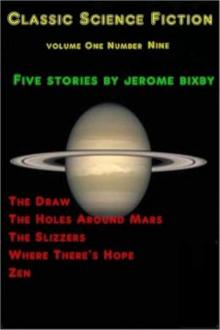 The Draw
The Draw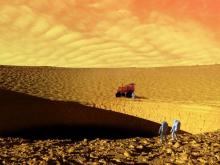 The Holes Around Mars
The Holes Around Mars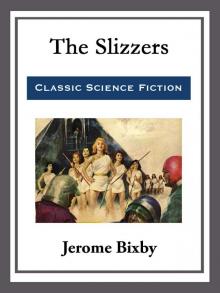 The Slizzers
The Slizzers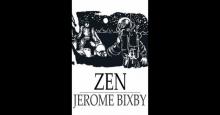 Zen
Zen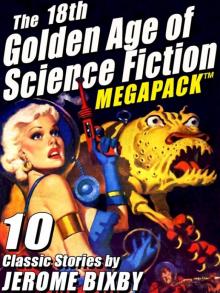 The 18th Golden Age of Science Fiction MEGAPACK ™: Jerome Bixby
The 18th Golden Age of Science Fiction MEGAPACK ™: Jerome Bixby